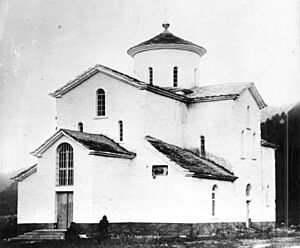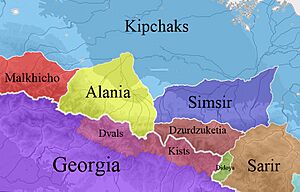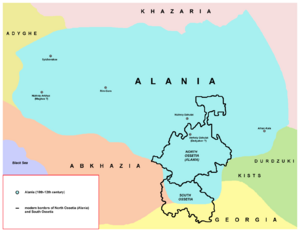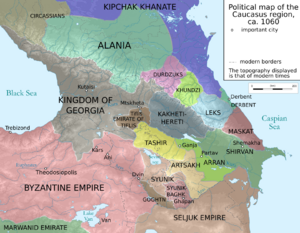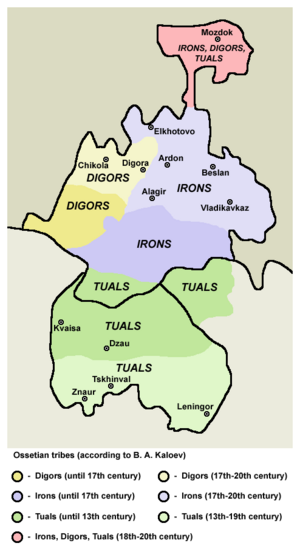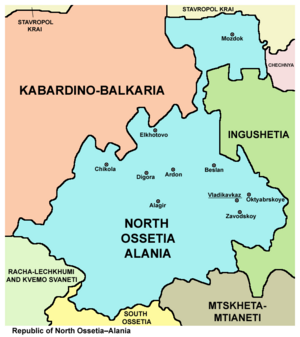History of North Ossetia–Alania facts for kids
The Republic of North Ossetia – Alania is a republic within Russia. It is located in the Caucasus mountains region.
Contents
Early History of North Ossetia
The land of North Ossetia has been lived on for thousands of years. It has good farmland and was an important trade route through the Caucasus Mountains. The people who live there today are descendants of a group called the Alans. They were a brave, traveling people who spoke an Iranian language.
Around the 7th century AD, some Alans settled in the Caucasus. By the 9th century, they had formed the kingdom of Alania. They became Christians, taught by missionaries from the Byzantine Empire. Many large churches were built, like the Zelenchuk churches. Alania became a strong state, making money from the famous Silk Road trade route to China, which passed through its lands.
From the Middle Ages onwards, Alania faced many attacks. In the 13th century, invasions by the Mongols and Tatars greatly reduced the population. These people were then known as Ossetians. In the 17th century, Islam was brought in by the Kabardians, a Muslim group. Attacks from the Khanate of Crimea and the Ottoman Empire eventually led Alania/Ossetia to join forces with Russia in the 18th century. North Ossetia was one of the first areas in the northern Caucasus to come under Russian control, starting in 1774. Its capital, Vladikavkaz, was Russia's first military base in the area. By 1806, all of Ossetia was under Russian rule.
Imperial Russia's Influence
When Imperial Russia arrived, the region quickly grew. New industries were started, and roads and railways were built to connect Ossetia with other places. The Georgian Military Road, which is still an important route through the mountains, was built in 1799. A railway line also connected Vladikavkaz to Rostov-on-Don in Russia.
The Ossetians' traditional way of life changed a bit as they became more connected to Russia. This process is sometimes called "russification." However, their new links with Russia and the West also helped their local culture grow. The first books in the Ossetian language were printed in the late 1700s. In 1830, a military effort led by General Ivan Abkhazov brought North Ossetia even more firmly under Russian control. The area became part of Russia's Terskaya Region in the mid-1800s.
Russian Revolution and Soviet Era
After the Russian Revolution of 1917, North Ossetia was part of the short-lived Soviet Mountain Republic in 1921. It later became the North Ossetian Autonomous Oblast in 1924. Then, on December 5, 1936, it was made the North Ossetian Autonomous Soviet Socialist Republic (ASSR) within the Russian Soviet Federated Socialist Republic.
During World War II, North Ossetia was a key battleground. Nazi Germany tried to capture Vladikavkaz in November 1942 but was stopped.
After the war, some groups of people were moved from their homes by the Soviet government. This affected the Balkars, Chechens, and Ingushs. For example, in 1944, a part of the Prigorodny District was given to North Ossetia after the Chechens and Ingush were moved to Central Asia. Even though these groups were later allowed to return, they often could not settle in their original areas. Instead, in 1957, some other districts were given to the Chechen-Ingush ASSR. A local law in North Ossetia in 1982 even made it difficult for ethnic Ingush people to live there.
After the Soviet Union
On June 20, 1990, North Ossetian ASSR became the first autonomous republic in Russia to declare its own sovereignty. In 1991, its name was changed to the Republic of North Ossetia–Alania.
When the Soviet Union broke apart, it created problems for the Ossetian people. They were divided between North Ossetia (part of Russia) and South Ossetia (part of Georgia). In December 1990, Georgia removed South Ossetia's special status due to rising tensions. Many people from South Ossetia then moved to North Ossetia or other parts of Georgia. About 70,000 South Ossetian refugees settled in North Ossetia. This led to conflicts with the Ingush people living in the Prigorodny District.
North Ossetia also had to deal with refugees and occasional fighting spilling over from the war in nearby Chechnya. The most tragic event was the Beslan hostage crisis in September 2004. A group of armed attackers took control of a school. When the crisis ended, 335 civilians, many of them children, sadly died.
See also
- History of Ossetia
- History of South Ossetia


